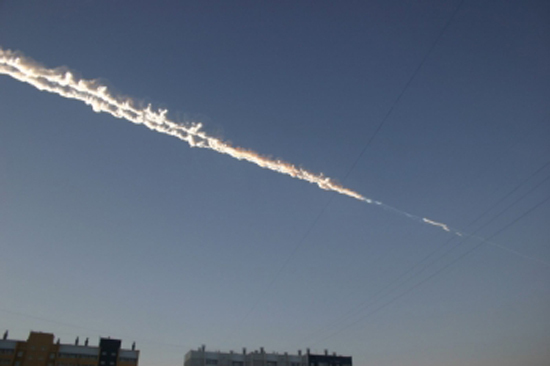Asteroid Threat Collides with Earthly Budget Realities in Congress

In the wake of last month's meteor strike in Russia and a close asteroid flyby on the same day, members of Congress asked NASA, White House and Air Force officials what they're doing to combat the threat of near-Earth asteroids during a hearing today (March 19) on Capitol Hill.
By and large, the experts stressed that the two space rock events were a coincidence and that the chance of a catastrophic asteroid impact to Earth any time soon is remote. On Feb. 15, a surprise meteor exploded in the sky over Russia's Ural Mountains, just hours before the 150-foot-wide (40 meters) asteroid 2012 DA14 flew close by Earth in a pass that had been predicted beforehand by scientists.
"The odds of a near-Earth object strike causing massive causalities and destruction of infrastructure are very small, but the potential consequences of such an event are so large that it makes sense to take the risk seriously," John Holdren, science advisor to President Barack Obama, told the Science, Space and Technology Committee of the U.S. House of Representatives.
Still, Rep. Lamar Smith (R-Texas), chairman of the Science, Space and Technology Committee, said it was "not reassuring" to learn that NASA has so far detected only about 10 percent of the near-Earth objects that are wider than 459 feet (140 meters) across. Holdren estimated that there may be hundreds of thousands of such objects within one-third the distance from Earth to the sun that remain unknown. [Meteor Streaks Over Russia, Explodes (Photos)]
In 2005, Congress directed NASA to detect, track and characterize 90 percent of these space rocks —those near-Earth asteroids larger than 459 feet feet (140 m). The space agency's chief, Charles Bolden, said today that NASA was unlikely to meet that deadline given its current budget.
"Our estimate right now is at the present budget levels it will be 2030 before we're able to reach the 90 percent level as prescribed by Congress," Bolden said.
Bolden criticized the lawmakers for slowing NASA down through budget cuts. "You all told us to do something, and between the administration and the Congress, the bottom line is the funding did not come," Bolden said.
Get the Space.com Newsletter
Breaking space news, the latest updates on rocket launches, skywatching events and more!
Furthermore, he said the goal of finding a way to respond to asteroid threats has been repeatedly put off by lawmakers who cite a lack of money.
Rep. Bill Posey (R-Fla.) asked what NASA would do if a large asteroid headed on a collision course with Earth was discovered today with only three weeks before impact.
"The answer to you is, 'if it's coming in three weeks, pray,'" Bolden said. "The reason I can't do anything in the next three weeks is because for decades we have put it off."
Budget concerns also hamper the military's ability to monitor near-Earth objects and other space threats, such as orbital debris (defunct satellites and spent rocket stages that litter Earth orbit).
"We are clearly less capable under sequestration," Gen. William Shelton, the current commander of the U.S. Air Force Space Command, told the committee. He said that any further budget cuts could have dire consequences.
"Our dependence on space, not only for our way of life but also for military operations, is very high, so we would sacrifice that," Shelton said.

This story was updated at 4:56 p.m. ET to correct the size of large near-Earth asteroids (459 feet, or about 140 meters) NASA seeks to identify under its 2005 congressional mandate.
Follow Clara Moskowitz on Twitterand Google+. Follow us @Spacedotcom, Facebook and Google+. Original article on SPACE.com.
Join our Space Forums to keep talking space on the latest missions, night sky and more! And if you have a news tip, correction or comment, let us know at: community@space.com.

Clara Moskowitz is a science and space writer who joined the Space.com team in 2008 and served as Assistant Managing Editor from 2011 to 2013. Clara has a bachelor's degree in astronomy and physics from Wesleyan University, and a graduate certificate in science writing from the University of California, Santa Cruz. She covers everything from astronomy to human spaceflight and once aced a NASTAR suborbital spaceflight training program for space missions. Clara is currently Associate Editor of Scientific American. To see her latest project is, follow Clara on Twitter.









